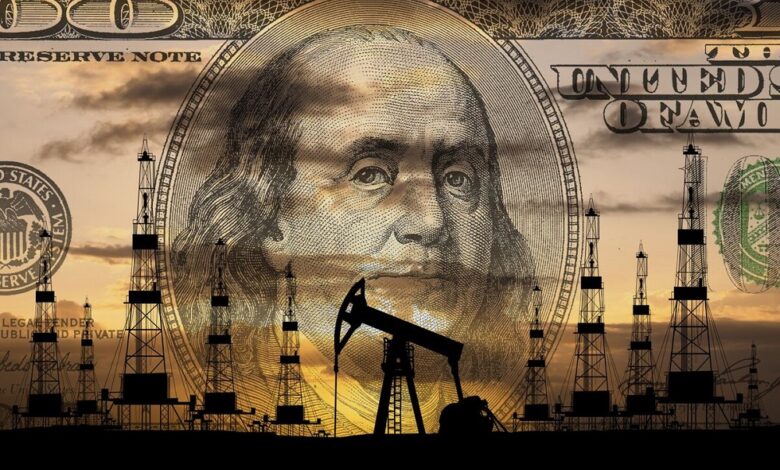
By Hippolyte Fofack
Special to The Times Kuwait
Much of the reporting earlier this month about the ‘non-renewal’ of a decades-old ‘petrodollar agreement’ between Saudi Arabia and the United States was riddled with inaccuracies and half-truths. Some outlets even went so far as to allege that Saudi Arabia would “stop using the US dollar for oil sales.” Still, despite these errors, and although the dollar remains dominant, the momentum for de-dollarization is building, reflecting broad geopolitical and macroeconomic shifts.
The petrodollar system — whereby oil is priced in dollars and oil-exporting countries invest surplus revenues in dollar-denominated assets — emerged in the mid-1970s, after US President Richard Nixon ended the greenback’s convertibility into gold. This helped smooth the transition to the post-Bretton Woods system of floating exchange rates. More crucially still, it cemented the dollar’s position as the world’s reserve currency and delivered decades of prosperity for Americans, who benefited from being the preferred market for global corporations in a context of increasing global demand for the greenback and capital inflows into the US.
The arrangement is rooted in a secret 1974 deal between Saudi Arabia and the US: the Saudis would recycle their petrodollars in US Treasuries in exchange for an American security guarantee, thus creating a strategic alliance that has shaped global politics for decades. By the next year, all of OPEC had agreed to price oil in dollars and invest in US government debt, allowing American banks to extend loans to countries in the Global South amid increasing financial-market deregulation.
As oil became the crucial resource for powering economic growth, industrialization, and technological advancement, oil-importing countries needed dollars to pay for their energy. At the same time, the global population boom increased demand for manufactured goods and oil, further strengthening the dollar’s position. By 2000, more than 70 percent of all foreign-exchange reserves were held in dollars, which dominated international trade (dollar invoicing encouraged exporters to borrow dollars to hedge and importers to borrow dollars for working capital) even as the industrialized Asian economies eroded America’s share of it.
Though the dollar’s dominance was not without challenges — most notably the financialization of the US economy and the precipitous decline in domestic manufacturing — the benefits that accrued to America were immense. The influx of foreign capital into US Treasuries supported low interest rates and a robust bond market, turning Wall Street into the world’s preeminent financial center. Today, around 70 percent of foreign-currency debt is dollar-denominated. Moreover, issuing the world’s reserve currency meant the US did not have to worry about trade deficits, allowing its economy “to give without taking, to lend without borrowing, and to acquire without paying”, as the French economist Jacques Rueff put it.
More recently, however, there have been moves toward de-dollarization. Central banks more than doubled their gold purchases between 2021 and 2022, and maintained a similar level in 2023. Equally important, local-currency settlement (LCS) for bilateral trade has become more common. In 2023, India made its first-ever rupee payment for crude oil from the United Arab Emirates, and China used the renminbi to settle around half of its cross-border trade and investment, leveraging its Cross-Border Interbank Payments System and the currency-swap agreements that the People’s Bank of China has signed with more than 40 central banks.
The shift away from petrodollars can be attributed to several factors. Before 2000, the US was the world’s biggest trading partner to more than 80 percent of the world’s countries, whereas now that number has dropped to less than 30 percent, and China has largely assumed America’s previous role. The global energy landscape has also changed significantly. The US used to rely heavily on Saudi Arabia for oil, but its shale boom in the mid-2000s put the country on the path to energy independence. Now China is the leading importer of Saudi oil, although many countries, including Saudi Arabia itself, are embracing renewables to accelerate the green transition.
The rise of the Global South, thanks to increasing technology diffusion and globalization of value chains, and heightened geopolitical tensions are driving the world toward a multipolar order, while America’s extensive use of sanctions has highlighted the political and financial risks of relying on the greenback as a reserve currency, medium of exchange, and a unit of account. De-dollarization is increasingly seen as the best way to mitigate these risks and enhance growth. As a result, countries are diversifying their foreign-exchange reserves: In 2022, the dollar’s share of global reserves fell ten times faster than over the previous two decades, to 58 percent, from 73 percent in 2001.
Meanwhile, digitalization has facilitated the use of LCS for cross-border trade and payments, bypassing the constraints associated with dollar funding and strengthening financial resilience. For example, the central banks of Indonesia, Malaysia, Singapore, and Thailand recently implemented a QR-code-based system that allows residents to make digital cross-border payments without using a vehicle currency.
The acceleration of de-dollarization is undeniable. The International Monetary Fund found that, in 125 economies, the median usage of renminbi in cross-border payments with China increased from 0 percent in 2014 to 20 percent in 2021; for a quarter of these economies, renminbi usage has risen to 70 percent. The shift away from petrodollars is an important factor. In 2023, one-fifth of global oil trade was settled in non-dollar currencies. And Saudi Arabia’s deepening energy ties with China have led to long-term oil-trading contracts denominated in renminbi (‘petroyuan’).
In an emerging multipolar world, digitalization is enabling economies to develop alternative payment mechanisms. The Federal Reserve Bank of New York recently acknowledged that a small group of countries have “declining dollar shares in official reserves,” while a handful of central banks are increasing gold purchases.
As geopolitical risks continue to erode trust, these numbers will keep rising. Drawing on digitalization to create a plurilateral framework for settling cross-border transactions in local currencies will be crucial to avoiding a costly fragmentation of the global payments system in a multipolar world.

Hippolyte Fofack
A former chief economist and director of research at the African Export-Import Bank, is a Parker fellow with the SDSN at Columbia University, a research associate at the Harvard University Center for African Studies, a distinguished fellow at the Global Federation of Competitiveness Councils, and a fellow at the African Academy of Sciences.
Copyright: Project Syndicate, 2024.
www.project-syndicate.org











